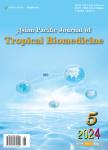Enzyme-treated date plum leave extract ameliorates atopic dermatitis-like skin lesion in hairless mice
作者机构:Research InstituteAto Q&A Co.LtdJeonju-siJeonbuk 54840Republic of Korea Department of Health ManagementJeonju UniversityJeonju-siJeonbuk 55069Republic of Korea Department of Agro-Bio and Food IndustryJeonju UniversityJeonju-siJeonbuk 55069Republic of Korea Department of Food Science and TechnologyChonbuk National UniversityJeonju-siJeonbuk 54896Republic of Korea
出 版 物:《Asian Pacific Journal of Tropical Biomedicine》 (亚太热带生物医学杂志(英文版))
年 卷 期:2020年第10卷第6期
页 面:239-247页
核心收录:
学科分类:1008[医学-中药学(可授医学、理学学位)] 1006[医学-中西医结合] 100602[医学-中西医结合临床] 10[医学]
基 金:financially supported by the Ministry of Small and Medium Enterprise and Startups(MSS),Korea “Regional Specialized Industry Development Program(Project number P0002904)”supervised by the Korea Institute for Advancement of Technology
主 题:Date plum leaves Enzyme Atopic dermatitis Inflammation Cytokine
摘 要:Objective: To evaluate the effect of different extracts of Diospyros lotus leaves in atopic dermatitis Methods: Diospyros lotus leaves were extracted in ethanol and treated with or without hydrochloric acid or α-rhamnosidase to obtain three different extracts-ethanol, acid-hydrolyzed, and enzyme-hydrolyzed leaf extracts of date plum. The myricitrin content in all samples was measured using HPLC analysis. In vitro antioxidant and anti-inflammatory activities of the extracts were determined by measuring DPPH radical scavenging activities and nitric oxide production in RAW264.7 cells, respectively. Sevenweek-old male hairless mice were used to evaluate the anti-atopic dermatitis effects of three extracts in vivo. Splenocytes and mast cells were used to further determine the anti-atopic dermatitis effects of the major compound in the ethanol leaf ***: Enzyme-hydrolyzed leaf extract showed significant in vitro antioxidant and anti-inflammatory activities, and attenuated atopic dermatitis-like skin symptoms and clinical signs more significantly than ethanol and acid-hydrolyzed leaf extracts in 1-fluoro-2,4-dinitrobenzene and house dust mite antigen-treated hairless mice. Enzyme-hydrolyzed leaf extract also suppressed the serum level of immunoglobulin E, interleukin(IL)-4, tumor necrosis factor(TNF)-α, interferon(IFN)-γ, thymic stromal lymphopoietin, and thymus and activation-regulated chemokine in mice with atopic dermatitis. Furthermore, histological analysis revealed that enzymehydrolyzed leaf extract suppressed the increased epidermal thickness, dermal infiltration of inflammatory cells, and infiltration and degranulation of mast cells more markedly than the other two extracts in atopic dermatitis-like skin lesions. In addition, this extract effectively inhibited the production of IFN-γ, IL-4, and thymus and activation-regulated chemokine compared with the other two extracts in concanavalin A-stimulated splenocytes. Myricitrin, a major compound of enzyme-hy



